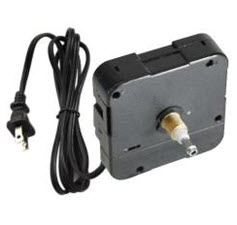Everything about Clock Movements and Motors

Clock motions and motors are the genuine digestive tracts of wrist watches. Clock movements as well as motors run mechanically or digitally, determining anytime in time the angle subtended by each specific hand. These interesting devices are our focus in this article.
Clock electric motors and activities are compatible terms that explain the exact same point, one term possibly preferred by laymen as well as the other by tradespersons. The earliest ones ran purely mechanically, transforming a flywheel based on the force coming from a hanging weight or securely wound springtime. A pendulum, in tandem with an escapement, worked as the regulator for the standard period of timing (usually the 2nd).
The modern-day clock activity is digital as opposed to mechanical. Its heart is a quartz crystal that shakes (reverberates) at a precise regularity derived from the crystal geometry. A collection of numerical signs up subdivides the all-natural frequency right into appropriate timekeeping values.
Therefore the clock motor shows the moment by turning one pin (connected to the second hand) a full turn every min, another pin (minute hand) a full turn every hr, and also a 3rd pin entirely every 12 hrs or 24 Hr. These hands obviously point to symbols or numbers published on the clock face.
To accomplish independent rotation of all the hands, their corresponding spindles (or shafts) need to be concentric. Clocks utilize equipments with the variety of teeth in meticulously computed proportions to obtain the proper cycles. Hence, the "seconds" gear causes a tick of the "minutes" gear after 60 of its very own ticks, and similarly the "minutes" equipment triggers the "hrs" gear.
Thus standard timekeeping is achieved, with the lengthiest cycle being 12 hours. Nonetheless, there are various other structures as well as time extensions that utilize 24-hour cycles or even longer ones compared to that.
replacement electric clock movement
Within these structures are variants, sometimes refined, that are incorporated into the activity. For instance, one is typically offered the option in between second hands that tick audibly and also those that transform with a silent, continuous move. The tick is a carry-over from the practice of pendulum and also escapement movement (no longer needed but commonly in demand), while the sweep used is a common modern choice.
Some clock electric motors come with grand cycles that are regular monthly or once a week. To apply them calls for a 4th hand that indicates the day for a 31-day schedule month or to the day of the week. In these instances the chain of triggering up the cycle power structure is far more difficult.
An additional thing to think about is whether the clock will immediately get used to daylight conserving time or not. Some motions, particularly those for electronic clocks, could synchronize to the atomic clock criterion. This saves needing to by hand reset the timepiece and also stays clear of a semi-permanent mis-synchronization needs to Congress change the daytime cost savings days.
Some clock movements can displaying weather info as opposed to, or along with, showing the moment. Typical data are temperature level, barometric pressure, and moisture, which are acquired from sensors rather than calculated according to a cycle. However, weather movements revealing tidal info (i.e., tide degree) track both lunar and solar cycles, as well as they also include influences based on local conditions.
Showing climate data requires at least an added hand or hands, and also it might additionally call for particularly calibrated dials. To earn tidal displays precise, one additionally has to adjust the electric motor itself.
We have actually taken a look at the main functions of motors; currently we intend to discuss the extra or secondary functions that they supply. These are either developed into the tool itself or are given as attachments with their very own buttons.
First off, common clock motions equip enough torque to revolve tiny- or medium-sized hands a cycle. (This suggests that the size of the minute hand, from pivot indicate tip, goes to the majority of 6 inches.) What about huge clocks?
As clock hands grow they also obtain heavier. Standard movements are not solid sufficient to turn them. In these situations, the clockmaker should search for a high torque model with the very same collection of attributes as the common version.
We currently dedicate a word or 2 regarding power. Mechanical clocks owned the functions with weights or springs, as well as these naturally had to be reset to their optimal potential energy states occasionally. Nowadays electrical energy is the driving pressure, calling for power cables connecteded into wall surface outlets or batteries (e.g., C or AA cells).
Batteries have to be changed every so often, and electrical energy stops to move when the power goes out. This is rarely an important concern, though preserving accurate time is essential in some circumstances. A good remedy is to equip the clock with both a power cable and also a battery.
By doing this, one kind of electrical energy can take over when the various other is failing. A variant on this theme is the uninterruptible power supply (UPS). An additional idea, especially beneficial for outdoors, is to make use of solar clocks the rechargeable batteries for which obtain juiced through solar power.
To have Westminster (or various other patterned) chimes play in the residence, consider utilizing chiming clock movements. To have the novelty of oscillating pendulums affixed to your clocks, order this feature (as the majority of activities give it). And that is all there is to understand about clock motions and motors.